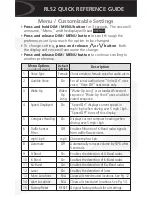
and receiver on two parallel traverse lines and the line between the transmitter and receiver aligned
perpendicular to the transect direction.
Each method has its advantages and disadvantages. Under certain field conditions, collecting data with
the in-line method affords the operator somewhat greater control over unwanted movement of the coils
during data collection. Using the broadside method, controlling the orientation of the instrument can
prove more difficult, as the instrument may tend to swing from side to side as the operator walks along
the survey transect. This type of coil motion can have adverse affects on the quality of the data.
In areas of significant surface vegetation, in-line operation is advantageous, as the instrument presents a
smaller cross-section to surface obstructions such as high grass, brush, bushes, and trees. Operation in the
in-line orientation may be desirable in locations where the operator has a priori information regarding the
trend of linear conductive targets, such as large metallic utilities, the orientation of buried foundation
walls, or the strike of a geologic feature, such as a conductive dike. In-line survey transects can then be
collected perpendicular to the trend (strike) of the target, reducing possible asymmetries in the target
response.
As the transmitter and receiver are on separate transects, data collected along a survey transect in the
broadside orientation will cover a larger area than a traverse collected in the in-line orientation for an
instrument with fixed coil spacing. Operation in the broadside orientation will also (generally) produce
narrower, tighter anomalies, and therefore better spatial resolution than operation in the in-line
orientation. This is because standard data-point plotting convention for moving source methods is to plot
each measurement at the midpoint between the transmitter and receiver. Given a conductive target of
limited dimension and two traverses collected over the target, one in the in-line orientation and the other
in the broadside orientation, the number of survey data points along the transect at which the instrument
will register a response is much smaller for the broadside orientation than the in-line orientation. The
instrument response for an in-line transect over such a target will be stretched out along the line of the
transect in comparison to the response from an equivalent broadside transect.







































